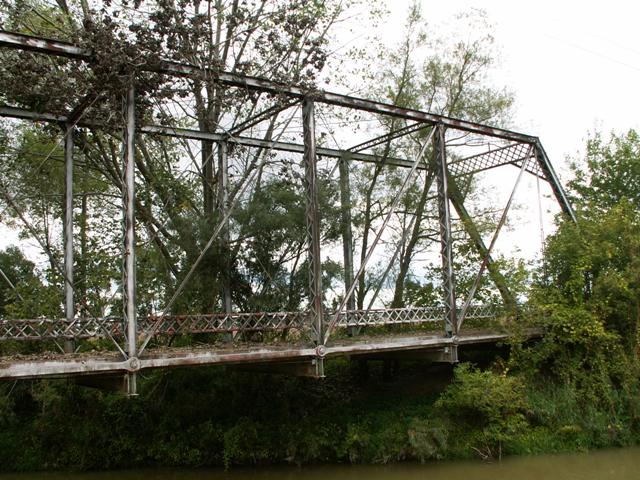We Recommend:
Bach Steel - Experts at historic truss bridge restoration.
BridgeHunter.com Phase 1 is released to the public! - Visit Now
CR-22 Bean Creek Bridge

Primary Photographer(s): Nathan Holth
Bridge Documented: 2005 and Fall/Winter 2006, October 20, 2017, and October 30, 2018
Not Available or Not Applicable
123.0 Feet (37.5 Meters)
126.0 Feet (38.4 Meters)
13 Feet (3.96 Meters)
1 Main Span(s)
2634724

View Information About HSR Ratings
Bridge Documentation
This bridge has the honor of being the first Ohio bridge to be featured on this website, and at the time it was a random discovery since it was not listed in any inventories.
This bridge is a beautiful pin connected Pratt through truss. The bridge is composed of eight panels, and its built-up beams include v-lacing on vertical members, on the sway bracing and under the top chord. Eyebars on the bridge are the up-set style. Original simple hub-guard style lattice guardrails are present on the bridge. The deck is a jack-arch design consisting of concrete with arched corrugated steel under. Portal bracing is a lattice design. The bridge sits on concrete abutments. The bridge still has a fair amount of silver paint left on it.
The design of the portal bracing and apparent ca. 1910 construction date of this bridge suggests that this bridge may have been built by the Massillon Bridge Company of Massillon, Ohio as this bridge's portal bracing resembles the design they used in the first decade of the 20th Century.
This bridge would be nice to see moved to a different location and restored for pedestrian use on a trail or in a park. This has been done with other Ohio bridges. Either way, something needs to be done before a large willow tree that is half tipped over on the bridge falls all the way down and crushes the bridge. The bridge is becoming very overgrown.
There is a second truss bridge a short distance south of this bridge.
Information and Findings From Ohio's Historic Bridge InventorySetting/Context The bridge carries an abandoned road over a stream in a sparsely developed, rural setting. Physical Description The 1 span, pin-connected Pratt thru truss bridge is traditionally composed with built-up compression members and eyebar or rod tension members. It has lattice portals and railings. Summary of Significance According to ODOT's environmental review files, this abandoned bridge is former SFN 2634724, which was a surveyed non-select bridge in 1981. The 1910 pin-connected Pratt thru truss bridge is later example of a
common type/design and has no distinctive details or features. The not eligible recommendation of the prior inventory remains appropriate. Bridge Considered Historic By Survey: No |
This bridge is tagged with the following special condition(s): Unorganized Photos
![]()
Photo Galleries and Videos: CR-22 Bean Creek Bridge
Bridge Photo-Documentation
A collection of overview and detail photos. This photo gallery contains a combination of Original Size photos and Mobile Optimized photos in a touch-friendly popup viewer.Alternatively, Browse Without Using Viewer
![]()
Additional Unorganized Photos
Original / Full Size PhotosA supplemental collection of photos that are from additional visit(s) to the bridge and have not been organized or captioned. This gallery offers photos in the highest available resolution and file size in a touch-friendly popup viewer.
Alternatively, Browse Without Using Viewer
![]()
Additional Unorganized Photos
Mobile Optimized PhotosA supplemental collection of photos that are from additional visit(s) to the bridge and have not been organized or captioned. This gallery features data-friendly, fast-loading photos in a touch-friendly popup viewer.
Alternatively, Browse Without Using Viewer
![]()
Maps and Links: CR-22 Bean Creek Bridge
Coordinates (Latitude, Longitude):
Search For Additional Bridge Listings:
Bridgehunter.com: View listed bridges within 0.5 miles (0.8 kilometers) of this bridge.
Bridgehunter.com: View listed bridges within 10 miles (16 kilometers) of this bridge.
Additional Maps:
Google Streetview (If Available)
GeoHack (Additional Links and Coordinates)
Apple Maps (Via DuckDuckGo Search)
Apple Maps (Apple devices only)
Android: Open Location In Your Map or GPS App
Flickr Gallery (Find Nearby Photos)
Wikimedia Commons (Find Nearby Photos)
Directions Via Sygic For Android
Directions Via Sygic For iOS and Android Dolphin Browser
USGS National Map (United States Only)
Historical USGS Topo Maps (United States Only)
Historic Aerials (United States Only)
CalTopo Maps (United States Only)


